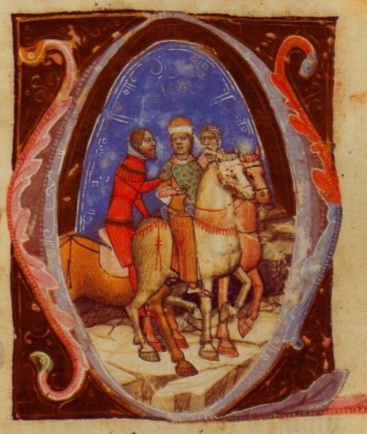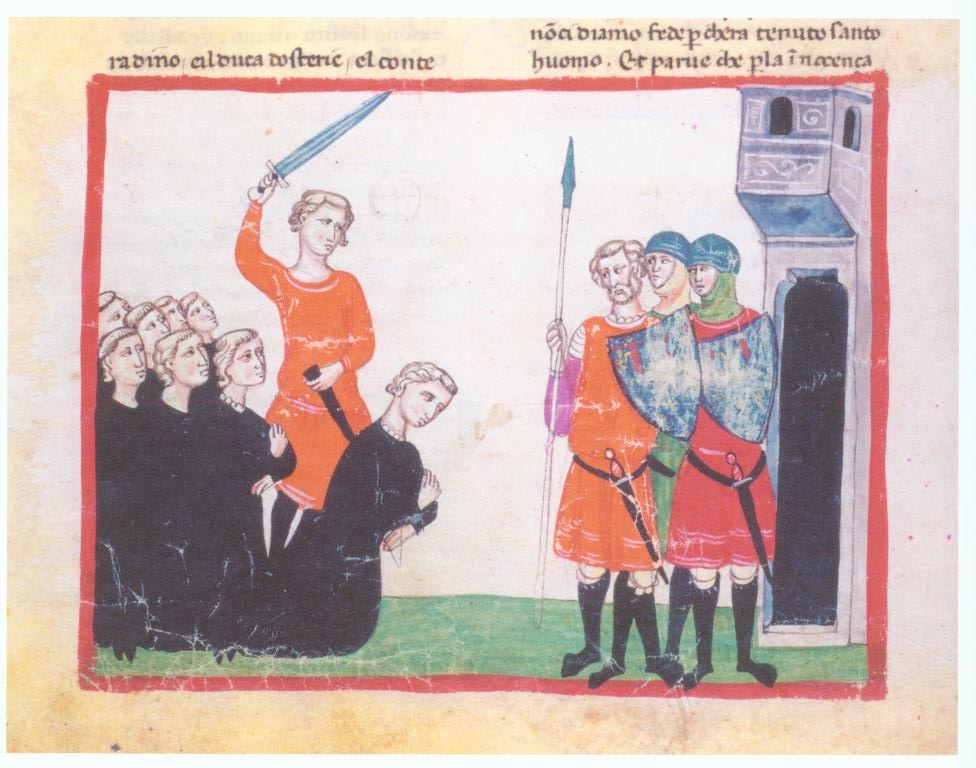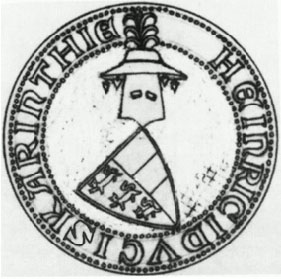|
Elisabeth Of Carinthia
Elizabeth of Carinthia (1298–1352) was Queen of Sicily by marriage to Peter II of Sicily. She was the regent of Sicily during the minority of her son Louis, King of Sicily from 1348 until her death in 1352. The daughter of the Otto, the penultimate duke of Carinthia and lord of Carniola from the House of Gorizia, she married Peter II of Sicily in 1323 and became the Queen of Sicily. During her time as Queen, Elizabeth ensured that the royal lineage of the Aragonese in Sicily continued. Two sons eventually ascended the throne, Louis of Sicily and Frederick IV of Sicily. Elizabeth was the regent for her young son Louis from 1348 until her death in 1352. Politically, the decades leading up to Elizabeth's reign were full of conflicts between Frederick III, King of Sicily, and Robert of Naples who had the backing of the papacy in Avignon. Famine, warfare, and plague were widespread in Europe during the mid-fourteenth century, which had a devastating impact on Sicily in particu ... [...More Info...] [...Related Items...] OR: [Wikipedia] [Google] [Baidu] |
Elizabeth Of Carinthia, Queen Of Germany
Elisabeth of Carinthia (also known as Elisabeth of Tyrol; – 28 October 1312), was a Duchess of Austria from 1282 and Queen of the Romans from 1298 until 1308, by marriage to King Albert I of Habsburg. Life Born in Munich, Bavaria, she was the eldest daughter of Count Meinhard of Gorizia-Tyrol, and Elizabeth of Bavaria, Queen of Germany, widow of the late Hohenstaufen King Conrad IV of Germany. Elizabeth thus was a half-sister of Conradin, King of Jerusalem and Duke of Swabia. Elizabeth was in fact better connected to powerful German rulers than her future husband: a descendant of earlier monarchs, for example Emperor Frederick Barbarossa, she was also a niece of the Bavarian dukes, Austria's important neighbors. Duchess and Queen She was married in Vienna on 20 December 1274 to Count Albert I of Habsburg, eldest son and heir of the newly elected Rudolf I, King of the Romans, thus becoming daughter-in-law of the King of the Romans and Emperor-to-be. After Rudolf had defeat ... [...More Info...] [...Related Items...] OR: [Wikipedia] [Google] [Baidu] |
Robert Of Naples
Robert of Anjou ( it, Roberto d'Angiò), known as Robert the Wise ( it, Roberto il Saggio; 1276 – 20 January 1343), was King of Naples, titular King of Jerusalem and Count of Provence and Forcalquier from 1309 to 1343, the central figure of Italian politics of his time. He was the third son of King Charles II of Naples and Mary of Hungary, and during his father's lifetime he was styled Duke of Calabria (1296–1309). Biography Robert was born around 1276, the third son of the future Charles II of Naples (then heir apparent) and his wife Mary of Hungary. His father was the son of the incumbent King of Naples, Charles of Anjou, who had established an Italian realm a decade earlier in 1266. During the Sicilian Vespers directed against his grandfather Charles, Robert was the hostage of Peter III of Aragon, his grandfather's enemy. In 1285, Robert’s grandfather died at Foggia in Italy, leading to his father (then a hostage) becoming King of Naples as Charles II, with Robert's ... [...More Info...] [...Related Items...] OR: [Wikipedia] [Google] [Baidu] |
Kingdom Of Hungary (1301–1526)
In the Late Middle Ages, the Kingdom of Hungary, a country in Central Europe, experienced a period of interregnum in the early 14th century. Royal power was restored under Charles I (1308–1342), a scion of the Capetian House of Anjou. Gold and silver mines opened in his reign produced about one third of the world's total production up until the 1490s. The kingdom reached the peak of its power under Louis the Great (1342–1382) who led military campaigns against Lithuania, southern Italy and other faraway territories. The expansion of the Ottoman Empire reached the kingdom under Sigismund of Luxemburg (1387–1437). In the next decades, a talented military commander, John Hunyadi, directed the fight against the Ottomans. His victory at Nándorfehérvár (present-day Belgrade, Serbia) in 1456 stabilized the southern frontiers for more than half a century. The first king of Hungary without dynastic ancestry was Matthias Corvinus (1458–1490), who led several succes ... [...More Info...] [...Related Items...] OR: [Wikipedia] [Google] [Baidu] |
Charles I Of Hungary
Charles I, also known as Charles Robert ( hu, Károly Róbert; hr, Karlo Robert; sk, Karol Róbert; 128816 July 1342) was King of Hungary and Croatia from 1308 to his death. He was a member of the Capetian House of Anjou and the only son of Charles Martel, Prince of Salerno. His father was the eldest son of Charles II of Naples and Mary of Hungary. Mary laid claim to Hungary after her brother, Ladislaus IV of Hungary, died in 1290, but the Hungarian prelates and lords elected her cousin, Andrew III, king. Instead of abandoning her claim to Hungary, she transferred it to her son, Charles Martel, and after his death in 1295, to her grandson, Charles. On the other hand, her husband, Charles II of Naples, made their third son, Robert, heir to the Kingdom of Naples, thus disinheriting Charles. Charles came to the Kingdom of Hungary upon the invitation of an influential Croatian lord, Paul Šubić, in August 1300. Andrew III died on 14 January 1301, and within four m ... [...More Info...] [...Related Items...] OR: [Wikipedia] [Google] [Baidu] |
Central Europe
Central Europe is an area of Europe between Western Europe and Eastern Europe, based on a common historical, social and cultural identity. The Thirty Years' War (1618–1648) between Catholicism and Protestantism significantly shaped the area's history. The concept of "Central Europe" appeared in the 19th century. Central Europe comprised most of the territories of the Holy Roman Empire and those of the two neighboring kingdoms of Poland and Hungary. Hungary and parts of Poland were later part of the Habsburg monarchy, which also significantly shaped the history of Central Europe. Unlike their Western European (Portugal, Spain et al.) and Eastern European (Russia) counterparts, the Central European nations never had any notable colonies (either overseas or adjacent) due to their inland location and other factors. It has often been argued that one of the contributing causes of both World War I and World War II was Germany's lack of original overseas colonies. After Wor ... [...More Info...] [...Related Items...] OR: [Wikipedia] [Google] [Baidu] |
Conradin
Conrad III (25 March 1252 – 29 October 1268), called ''the Younger'' or ''the Boy'', but usually known by the diminutive Conradin (german: link=no, Konradin, it, Corradino), was the last direct heir of the House of Hohenstaufen. He was Duke of Swabia (1254–1268) and nominal King of Jerusalem (1254–1268) and Sicily (1254–1258). After his attempt to reclaim the Kingdom of Sicily for the Hohenstaufen dynasty failed, he was captured and beheaded. Early childhood Conradin was born in Wolfstein, Bavaria, to Conrad IV of Germany and Elisabeth of Bavaria. Though he never succeeded his father as Roman-German king, he was recognized as king of Sicily and Jerusalem by supporters of the Hohenstaufens in 1254. Having lost his father in 1254, he grew up at the court of his uncle and guardian, Louis II, Duke of Bavaria. His guardians were able to hold Swabia for him. Jerusalem was held by a relative from the royal house of Cyprus as regent. In Sicily, his father's half-brothe ... [...More Info...] [...Related Items...] OR: [Wikipedia] [Google] [Baidu] |
Spanheim
The House of Sponheim or Spanheim was a medieval German noble family, which originated in Rhenish Franconia. They were immediate Counts of Sponheim until 1437 and Dukes of Carinthia from 1122 until 1269. Its cadet branches ruled in the Imperial County of Ortenburg-Neuortenburg and various Sayn-Wittgenstein states until 1806. History The family took its name from their ancestral seat at Sponheim Castle in the Hunsrück range, in present-day Burgsponheim near Bad Kreuznach, Rhineland-Palatinate. From the 11th century the family was divided in two closely related branches. One of these branches, probably the senior one, retained the Duchy of Carinthia and originated the County of Ortenburg in Bavaria. The other one remained in Rhenish Franconia, retaining the County of Sponheim. The founder of the ducal branch was Count Siegfried I (1010–1065), a Ripuarian Frank by birth and retainer of the Salian emperor Conrad II. For this reason the family is sometimes termed the ... [...More Info...] [...Related Items...] OR: [Wikipedia] [Google] [Baidu] |
Hohenstaufen
The Hohenstaufen dynasty (, , ), also known as the Staufer, was a noble family of unclear origin that rose to rule the Duchy of Swabia from 1079, and to royal rule in the Holy Roman Empire during the Middle Ages from 1138 until 1254. The dynasty's most prominent rulers – Frederick I (1155), Henry VI (1191) and Frederick II (1220) – ascended the imperial throne and also reigned over Italy and Burgundy. The non-contemporary name of 'Hohenstaufen' is derived from the family's Hohenstaufen Castle on the Hohenstaufen mountain at the northern fringes of the Swabian Jura, near the town of Göppingen. Under Hohenstaufen rule, the Holy Roman Empire reached its greatest territorial extent from 1155 to 1268. Name The name Hohenstaufen was first used in the 14th century to distinguish the 'high' (''hohen'') conical hill named Staufen in the Swabian Jura (in the district of Göppingen) from the village of the same name in the valley below. The new name was only applied to the h ... [...More Info...] [...Related Items...] OR: [Wikipedia] [Google] [Baidu] |
Silesia
Silesia (, also , ) is a historical region of Central Europe that lies mostly within Poland, with small parts in the Czech Republic and Germany. Its area is approximately , and the population is estimated at around 8,000,000. Silesia is split into two main subregions, Lower Silesia in the west and Upper Silesia in the east. Silesia has a diverse culture, including architecture, costumes, cuisine, traditions, and the Silesian language (minority in Upper Silesia). Silesia is along the Oder River, with the Sudeten Mountains extending across the southern border. The region contains many historical landmarks and UNESCO World Heritage Sites. It is also rich in mineral and natural resources, and includes several important industrial areas. The largest city and Lower Silesia's capital is Wrocław; the historic capital of Upper Silesia is Opole. The biggest metropolitan area is the Upper Silesian metropolitan area, the centre of which is Katowice. Parts of the Czech city of Ostrava a ... [...More Info...] [...Related Items...] OR: [Wikipedia] [Google] [Baidu] |
Henry Of Bohemia
Henry of Gorizia (german: Heinrich, cs, Jindřich; – 2 April 1335), a member of the House of Gorizia, was Duke of Carinthia and Landgrave of Carniola (as Henry VI) and Count of Tyrol from 1295 until his death, as well as King of Bohemia, Margrave of Moravia and titular King of Poland in 1306 and again from 1307 until 1310. After his death, the Habsburgs took over Carinthia and Carniola and held them almost without interruption until 1918. Life Henry was a younger son of Count Meinhard II of Görz-Tyrol and Elizabeth of Bavaria, widow of King Conrad IV of Germany. Upon the partition of the Meinhardiner estates in 1271, his father maintained the Tyrolean lands, while Henry's uncle Albert received the County of Gorizia. In 1276 Count Meinhard married his eldest daughter, Henry's sister Elizabeth, to Albert, son of King Rudolph I of Germany, and in turn was enfeoffed with the Duchy of Carinthia in 1286. After his father's death in late October 1295, Henry inherited the Tyro ... [...More Info...] [...Related Items...] OR: [Wikipedia] [Google] [Baidu] |
Mark An Der Sann
The (German for " March on the Savinja"; other designations and variations of the name include , (or ), () and , as well as simply – Savinja valley) was a border march of the Holy Roman Empire, in the territory of present-day Slovenia. It was established in the second half of the 10th century to protect the Empire against its enemies to the east, especially from Hungarian raids. Territory The territory included the catchment of the Savinja river, extending to the Sotla in the east. To the south, the March extended to the right bank of the river Sava and included the Krka basin, and the area around Višnja Gora. From the 14th to the 16th century, the area on the right bank of the Sava was known as the Windic March (or Slovene March), while the left bank became known as the County of Cilli (Celje) from 1341 to 1456. In the early modern period, the former was fully incorporated into the Duchy of Carniola, and the latter into the Duchy of Styria, completing a long proc ... [...More Info...] [...Related Items...] OR: [Wikipedia] [Google] [Baidu] |
March Of Carniola
The March (or Margraviate) of Carniola ( sl, Kranjska krajina; german: Mark Krain) was a southeastern state of the Holy Roman Empire in the High Middle Ages, the predecessor of the Duchy of Carniola. It corresponded roughly to the central Carniolan region of present-day Slovenia. At the time of its creation, the march served as a frontier defense against the Kingdoms of Hungary and Croatia. History Before the coming of the Romans (c. 200 BC), the Taurisci dwelt in the north of Carniola, the Pannonians in the south-east, the Iapodes or Carni, a Celtic tribe, in the south-west. Carniola formed part of the Roman province of Pannonia; the northern part was joined to Noricum, the south-western and south-eastern parts and the city of Aemona to Venice and Istria. In the time of Augustus all the region from Aemona to Kolpa river belonged to the province of Savia. After the fall of the Western Roman Empire (476), Carniola was incorporated into the Kingdom of Italy, and (493) under Th ... [...More Info...] [...Related Items...] OR: [Wikipedia] [Google] [Baidu] |





